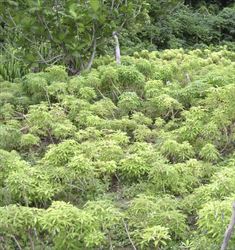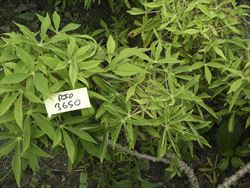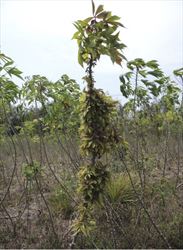Cassava phytoplasma diseases.
Pacific Pests, Pathogens, Weeds & Pesticides - Online edition
Pacific Pests, Pathogens, Weeds & Pesticides
Cassava phytoplasma diseases (521)
Classified as Candidatus Phytoplasma, with the species determined by tests of the 16S ribosomal RNA gene. The phytoplasmas of cassava fall into several groups, e.g., Candidatus Phytoplasma asteris, 16SrI; Candidatus Phytoplasma aurantifolia, 16SrII, and others. This way of naming them will remain until they can be cultured and tests prove they are the cause of the diseases associated with them.
Asia, Africa, South America, the Caribbean, Oceania. Cassava witches’ broom diseases are known in Southeast Asia (Cambodia, China, Indonesia, Laos, the Philippines, Thailand, and Vietnam). 'Frogskin' is known from Brazil, Colombia, Costa Rica, Panama, Peru, and Venezuela. Other diseases, as yet not well defined, occur in Brazil, Costa Rica, Cuba, Panama, Peru, Venezuela, and Wallis and Futuna.
Cassava. Possibly, alternative crops and wild hosts.
A number of diseases have emerged around the world that are associated with phytoplasmas. Proof that phytoplasmas are involved is difficult to obtain. These bacteria-like, phloem-dwelling organisms, without rigid cell walls, have proved difficult to isolate and culture. They are typically associated with 'yellows' diseases. In cassava, a variety of symptoms are reported: yellowing of leaves, bunching of foliage due to shortening of internodes (the distances between leaves) (Photos 1&2), the development of normally-dormant shoots to produce so-called witches' brooms', (the broomstick of a flying witch!) (Photos 3&4), or only occasional leaf mosaic symptoms until harvest when plants showed rough skin, banding, cracking and woodiness in thin storage roots. Occasionally, stems show internal discolouration of the vascular tissues (Photo 5). The following are some examples:
- Cassava frogskin disease (South America, many countries).
First reported in the early 1970s. An unusual disease in that there are few above ground symptoms, apart from slight swellings of lower stems, and curling and yellow/green patterns on leaves of some varieties. The roots are thin, woody, with thick outer layers, and deep cracks. Sometimes the cracks form a ring around the root. Recently, the phytoplasma associated with frogskin has been cultured on artificial media from root phloem. Affiliated with the 16SrIII group. - X-disease phytoplasma (Brazil).
Known since the 1940s. Losses of 70% are reported on stunted plants with yellow distorted leaves and abnormal multiple shoots. Affiliated with the 16SrIII group, but in a different sub-group from that associated with frogskin and associated with a witches' broom disease. - Witches’ broom of cassava (Thailand and Vietnam).
First reported in 2008 in Thailand, when it spread rapidly and is now widely distributed. Affected plants show bunching of shoots with short internodes, small yellowish leaves at the top of the plants, brown vascular tissues and poor storage root development. In Vietnam, symptoms are similar, with shoot proliferation and short internodes with, in some places, dark vascular tissue in the stems and roots. Associated with the Candidatus phytoplasma asteris, 16SrI group. - Unnamed phytoplasma disease (Uganda).
Plants have yellowish leaves and are slightly stunted. The weed, sticky mallow (Malvaviscus arborus), was found to be infected with the same phytoplasma. Affiliated with the Candidatus phytoplasma aurantifolia, 16SrII group. - Unnamed phytoplasma disease (Cote d’Ivoire).
Symptoms of yellowing and mosaic patterns on leaves in areas affected by coconuts with Cape St. Paul Wilt Disease phytoplasma. Tests showed that both are infected with a similar phytoplasma. Affiliated to the Candidatus phytoplasma palmicola, 16SrXXII group. - Unnamed phytoplasma disease (Wallis and Futuna).
Found only in Futuna. Leaves are yellow, and foliage appears more bunched than normal (Photos 1&2). Affiliated with the Candidatus phytoplasma aurantifolia, 16SrII group.
Spread of cassava phytoplasma diseases occurs in cuttings used for propagation. It is likely that insects also play a part, as the phytoplasmas are systemic, limited to phloem cells upon which a number of types of insects feed: leaf hoppers, plant hoppers, sharpshoots and psyllids. The insects that spread phytoplasmas of cassava are not well known, although several leafhopper and planthoppers have been identified as possibilities.
Cassava is the third most important crop in the tropics after rice and maize in terms of calories produced. Phytoplasma diseases of cassava are a threat to its production as an export crop (mainly Southeast Asia), and as food and income for smallholders. In Vietnam, for instance, the impact occurs in three ways: (i) direct yield loss (e.g., 60,000 ha were affected in 2010, with overall yield and starch losses of 30%); (ii) processors need to buy more cassava roots to make up for the shortfall in starch content; and (iii) farmers, who are paid on starch content, are paid less. In other regions affected by phytoplasma diseases, the impact is just as serious. In parts of Colombia and Brazil, for instance, epidemics of phytoplasma disease have resulted in yield losses of 70-90%.
No one symptom is diagnostic: symptoms are variable depending on phytoplasma involved, variety of cassava and possibly environmental conditions. Look for yellowing and bunching of foliage (see Photo 1); look for witches' broom symptoms, which may be accompanied by brown marks in the vascular tissue (Photo 5). Look for the frogskin symptoms on the storage roots. Molecular detection methods have been developed, including PCR, and loop mediated isothermal amplification (LAMP).
BIOSECURITY
The recent appearance of these diseases in different parts of the world suggests that they are new and, as such, must be monitored carefully. They reinforce the need for care when moving plants internationally. Unrestricted movement of infected planting material could spread phytoplasmas and other diseases. Transfers should only be made as pathogen-tested plants growing as sterile tissue cultures following the FAO/IBPGR (1991) Technical Guidelines for the Safe Movement of Cassava Germplasm. A priority in the management of these diseases is the use of clean planting material; however, such schemes are not common.
BIOLOGICAL CONTROL
None available. Insect spread not considered important in comparison to spread in planting material.
CULTURAL CONTROL
Before planting:
- Carefully choose plants for propagation. Ideally, those without symptoms of disease during the previous crop. This is the most important and probably the only effective method of managing these diseases, if sources of certified or approved cuttings are not available.
- Do not plant new plots of cassava near to those that have the disease.
During growth:
- Remove any plants with symptoms of phytoplasma as soon as they are seen: look out for witches’ broom symptoms, as well as stunted plants with abnormal yellow leaves.
After harvest:
- Collect and burn plants that show symptoms of disease.
RESISTANT VARIETIES
Differences between varieties exist, but convential breeding has not yet made an impact; emphasis has been towards Cassava mosaic virus and Cassava brown streak virus. More recently, however, attention has been directed towards the potential of gene-editng techniques and the production of transgenic crops.
CHEMICAL CONTROL
Not a method to use against cassava phytoplasma diseases: there is little known about the insects that may spread these diseases, and insects are unlikely to be as important as attempting control using cultural control, especially the careful choice of planting material and removing plants that show disease symptoms.
AUTHOR Grahame Jackson
Information from Cassava witches' broom disease. Pest management decision guide: green list. Plantwise. CAB International. (https://www.google.com/search?q=cassava+witches%27+broom+disease&oq=cassava+witches%27+broom+disease&aqs=chrome..69i57j0i22i30.16960j0j7&sourceid=chrome&ie=UTF-8); Alvarez E, et al. (2013) Detection and identification of ‘Candidatus Phytoplasma asteris’-related phytoplasmas associated with a witches’ broom disease of cassava in Vietnam. Phytopathogenic Mollicutes 3(2): 77-81; and Kta KD, et al. (2017) First report of a phytoplasma affecting cassava orchards in Cote d'Ivoire. New Disease Reports 35: 21. (https://www.ndrs.org.uk/article.php?id=35021#); and Arocha Y, et al. (2009) Occurrence of 'Candidatus Phytoplasma aurantifolia' (16SrII group) in cassava and other species in Uganda. Plant Pathology; and from Álvarez E (2019) Phytoplasma Diseases Affecting Cassava. In: Olivier C, Dumonceaux T, Pérez-López E (eds) Sustainable Management of Phytoplasma Diseases in Crops Grown in the Tropical Belt. Sustainability in Plant and Crop Protection, vol 12. Springer, Cham. (https://doi.org/10.1007/978-3-030-29650-6_7); and from Uke A., et al. Cassava mosaic disease and its management in Southeast Asia. Plant Mol Biol (2021). (https://doi.org/10.1007/s11103-021-01168-2). Photos 1&2 Richard Davis, DAWE, Australia. Photo 3 Cassava witches' broom - Cambodia. CIAT. (https://www.flickr.com/photos/ciat/albums/72157649202164460). Photos 4&5 Paul van Mele. Agro-Insight, Belgium. Cassava witches' broom, Thailand.
Produced with support from the Australian Centre for International Agricultural Research under project HORT/2016/185: Responding to emerging pest and disease threats to horticulture in the Pacific islands, implemented by the University of Queensland, in association with the Pacific Community.








